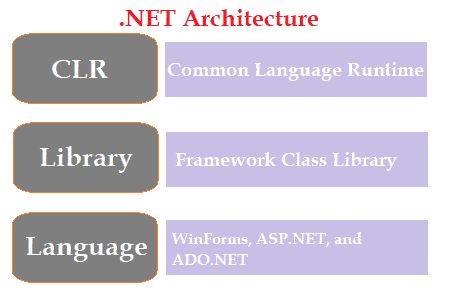.Net is a software development platform developed by Microsoft. It was meant to create applications, which would run on a windows platform. The first beta version was released in 2000.
Although C# is a computer language that can be studied on its own, it has a special relationship to its runtime environment, the .NET Framework.
The .NET Framework defines an environment that supports the development and execution of highly distributed, component-based applications. It enables differing computer languages to work together and provides for security, program portability, and a common programming model for the Windows platform.
The .Net Framework supports more than 60 programming languages such as C#, F#, VB.NET, J#, VC++, JScript.NET, APL, COBOL, Perl, Oberon, etc.
The following are the .NET Framework important entities.
- Common Language Runtime (CLR)
- Framework Class Library (FCL)
- Core Languages (WinForms, ASP.NET, and ADO.NET)

Common Language Runtime (CLR)
The Common Language Runtime (CLR) is the execution engine of the .NET Framework that loads and manages the execution of your program.
All .NET programs execute under the supervision of the CLR, guaranteeing certain properties and behaviors in the areas of memory management, provide security, Platform independent, garbage collection, and exception handling. It acts as an interface between the framework and the operating system.
Framework Class Library (FCL)
This library gives your program access to the runtime environment. It includes some set of standard class libraries that contains several properties and methods used for the framework purposes.
The Base Class Library (BCL) is the core of FCL and provides basic functionalities.
Core Languages
Following are the types of applications built in the .Net framework:
WinForms: It stands for windows form and is used to create form-based applications. It runs on the client end and notepad is an example of WinForms.
ASP.Net: It is a web framework, developed by Microsoft and is used to develop web-based applications. This framework is made to run on any web browser such as Internet Explorer, Chrome, etc. It was released in the year 2002.
ADO.Net: This module of the .Net framework was developed to form a connection between application and data sources (Databases). Examples of such modules are Oracle or Microsoft SQL Server. There are several classes present in ADO.Net that are used for the connection of database, insertion, deletion of data, etc.
